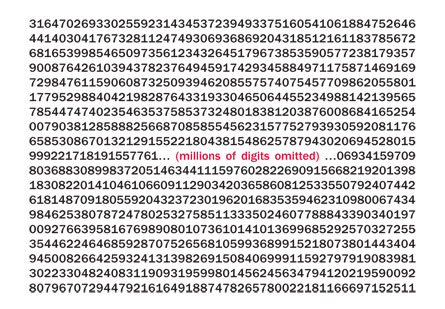Largest known prime: 2^43,112,609 - 1
By Murray Bourne, 22 Jun 2009
A reader wrote to say that there was an error on the page Number Properties in Interactive Mathematics. It said:
213466917 − 1. (This is huge - around 4 × 10506,756).
When I wrote the page, this was indeed the highest known prime, but in 2008, the GIMPS project (the distributed computing Great Internet Mersenne Prime Search) found an even larger one:
243,112,609 − 1
This prime has around 13 million digits. Here are some of them (with millions of digits omitted in the middle):

[Image source: ScienceNews - no longer available]
It's an example of a Mersenne Prime, which are of the form 2x − 1.
The first Mersenne Prime is 22 − 1 = 3, and the next is 23 − 1 = 7.
But not all numbers in this form are prime, for example 24 − 1 = 15 is not prime.
So finding primes is a matter of trying higher values of x in the expression 2x − 1 and testing if they can be factored.
What is a prime?
A prime has exactly 2 factors, itself and 1. So the first prime is the number 2 (factors 2 and 1).
Who Cares?
Every time you use a password to access a bank account or web site, there is a good chance that a large prime number was used in the encryption process.
Want to make some money with primes?
The Electronic Frontier Association paid $100,00 for the above prime, and are offering $150,000 for a prime with 100 million digits and $250,000 for one with 1 billion digits.
This is where distributed computing power becomes important — according to ZDNet, a single computer would need 500 years to test a billion-digit prime number.
Be the first to comment below.
